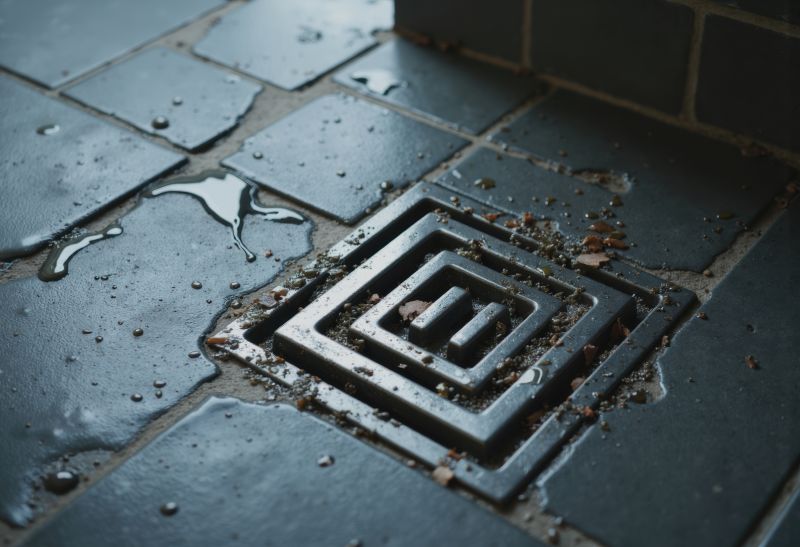Top-Rated Products For Drain Tile Installations To Simplify Your Project
Explore trusted drain tile tools and materials that help achieve professional results with ease and precision.
 Drain tile installation is a critical component in managing water flow around foundations, landscaping, and drainage systems. Proper installation helps prevent water accumulation that can lead to structural issues or landscape damage. The process involves selecting appropriate materials, such as perforated pipes and surrounding media, to facilitate efficient water movement away from problem areas. These systems are often customized based on site conditions, soil type, and drainage requirements, ensuring optimal performance.
Drain tile installation is a critical component in managing water flow around foundations, landscaping, and drainage systems. Proper installation helps prevent water accumulation that can lead to structural issues or landscape damage. The process involves selecting appropriate materials, such as perforated pipes and surrounding media, to facilitate efficient water movement away from problem areas. These systems are often customized based on site conditions, soil type, and drainage requirements, ensuring optimal performance.
Top Overall Option
Perforated Drainage Pipe
A perforated drainage pipe serves as the core component of many drain tile systems, designed to facilitate water flow while filtering out debris. When paired with appropriate gravel and geotextile fabric, it provides a versatile solution suitable for various site conditions. Its durability and flexibility make it a reliable choice for effective drainage management.
Types of Products For Drain Tile Installations
Perforated Corrugated Pipes
Flexible pipes with perforations designed for easy installation and effective water flow management.
Solid Drainage Pipes
Non-perforated pipes used in situations requiring controlled water flow or to serve as a conduit.
Geotextile Fabric
Porous fabric used to wrap around gravel and pipes, preventing soil intrusion and clogging.
Gravel and Crushed Stone
Aggregates used to surround pipes, aiding in water filtration and flow.
Drainage Fittings and Connectors
Various fittings to connect pipes and ensure proper directional flow and system integrity.
Filter Socks
Protective sleeves that prevent debris from entering perforations and clogging the system.
Drainage Boxes
Access points and collection chambers for inspecting and maintaining the drainage system.
Slope Guides and Markers
Tools to help ensure correct pipe slope during installation for optimal drainage.
Pipe Connectors and Couplings
Components that join sections of pipe securely and maintain system integrity.
Drainage Pumps
Pumps used to actively move water in systems where gravity drainage is insufficient.
Popular Choices
Widely used for its flexibility and ease of installation in various drainage projects.
Commonly selected for surrounding pipes due to its effective filtration properties.
Popular for connecting multiple pipes and creating a comprehensive drainage network.
Frequently chosen to wrap around pipes and gravel to prevent soil intrusion.
Commonly used for system access and maintenance in residential and commercial projects.
Popular for creating seamless pipe joints in complex drainage layouts.
Helpful tools for ensuring correct pipe slope during installation, often used in DIY projects.
Selected for managing water in areas with insufficient gravity flow, especially basements.
Popular for preventing debris entry and reducing clogging in perforated pipes.
Widely used as a base material around pipes to facilitate water flow and filtration.
A typical drain tile system consists of perforated pipes that allow water to enter and flow through them. These pipes are usually encased in gravel or other coarse aggregates to filter out debris and prevent clogging. Proper placement and slope are essential for effective drainage, and additional components like geotextile fabrics can be used to prevent soil intrusion. Installation techniques vary depending on the project scope, but the goal remains consistent: to create a reliable pathway for excess water to exit the area safely.
Choosing the right products for drain tile installation involves understanding the specific needs of your site. Factors such as soil permeability, water table level, and landscape layout influence the selection of pipes, fittings, and accessories. Quality materials and proper installation practices can significantly impact the longevity and effectiveness of the drainage system. Whether for residential foundations, large-scale landscaping, or agricultural applications, selecting suitable components ensures the system functions as intended over time.
Professional guidance or detailed research can assist in identifying the best materials and methods for your project. While many products are available on the market, understanding their features and compatibility with your site conditions is essential. Investing in durable, well-designed components can help achieve effective drainage, reduce maintenance needs, and protect property value. Proper planning and product selection are key steps toward a successful drain tile installation.
Key Buying Considerations
- Assess your site’s soil type and permeability to choose appropriate drainage materials.
- Determine the required pipe diameter based on the volume of water to be managed.
- Select perforation patterns that suit your drainage needs—full perforation for maximum flow or partial for controlled flow.
- Ensure compatibility of fittings and connectors for seamless system assembly.
- Consider the system’s slope and ensure proper grading for gravity-assisted drainage.
- Use geotextile fabric to prevent soil intrusion and clogging of pipes over time.
- Choose durable materials that withstand environmental conditions and soil pressure.
- Plan for access points such as inspection chambers for future maintenance.
- Evaluate the need for active drainage solutions like pumps in low-lying areas.
- Verify local building codes and regulations related to drainage system installation.
- Factor in future landscaping or construction plans that may affect the drainage layout.
- Consider the overall lifespan and ease of system repair or expansion.
- Determine if additional components like filter socks or slope guides are necessary for your project.
- Budget for proper installation tools and accessories to ensure system integrity.
- Consult with drainage professionals if uncertain about system design or material selection.
This content may contain affiliate links. We may earn a commission if you purchase through these links, at no additional cost to you.
